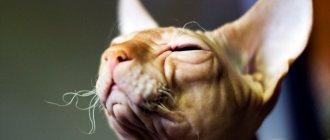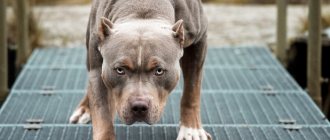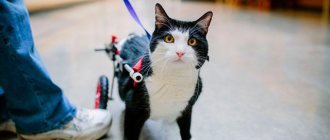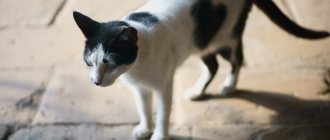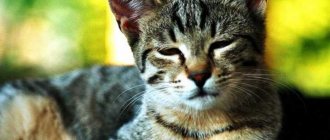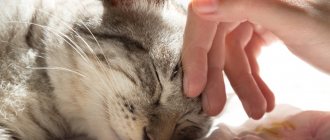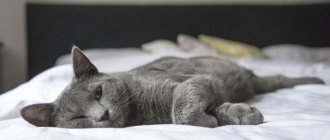Very often, owners of domestic cats observe a touching picture - the cat sleeps on its back, with its paws outstretched. In most cases, this pose indicates that the furry is happy, he completely trusts his owners. And only sometimes lying on the back is a cause for concern, as it signals problems in the cat’s body. So why does a cat like to lie on its back? List and explanation of possible reasons.
Trust in the owner
A pose on his back with his paws up is a sign that the fluffy completely trusts the situation and the person. This is only possible when a warm relationship is established between the owner and the animal. The cat sees protection in a person and trusts him to guard his sleep. Also, at the same time, fluffies can bend and hang from surfaces - this is how they express complete happiness and contentment with life.
REFERENCE! An indicator of special trust: the cat lies down on the floor, turns over on its back and begins to “stretch” in front of the owner.
Sleeping on your back: normal or pathological?
The instincts, behavior and habits of cats are in many ways similar to human ones. This applies not only to reactions and needs inherent in nature, but also to banal physical states: relaxation, tension, etc. During rest, a person can lie on his back, stomach, side, or in the fetal position. This is often due to the level of fatigue, mood, or a banal habit.
In their dreams, cats encounter different emotionally charged episodes.
Curious! Scientists conducted a number of experiments studying animals during sleep, in particular cats were experimental subjects. It turned out that they, like people, are no strangers to emotional dreams. Moreover, it was possible to decipher their contents. Mostly these are episodes of hunting, exploring the area, irritation and even fear.
They say that a cat sleeping on its back sees only good dreams.
Human and cat rest are similar in that during this time both are capable of experiencing happiness. For cats, one of the indicators of this condition is sleeping on their back. This body position is absolutely normal. There is no need to worry about the health of a kitten seen lying on its back with half-closed eyes.
Reasons for concern
Lying on your back can also serve as a signal about the development of certain pathologies. These can be diseases of the intestines, kidneys, inflammatory processes in the body. The cat falls on its back, while it does not allow its owners to approach it, does not allow it to be touched (attempts to palpate the stomach will cause attacks of aggression in the animal). There are also additional symptoms:
- lack of appetite;
- stool disorders;
- constant meowing;
- general lethargy or restless behavior.
Forced posture for illnesses
Health problems can cause forced sleep positions as the cat seeks the most comfortable body position to reduce discomfort and pain. The owner should sound the alarm if the unnatural position is accompanied by lethargy of the pet, refusal to eat, problems with natural functions, the presence of lumps in the abdomen, or plaintive meowing.
The reason for this situation may be:
- binge eating;
- bloating and intestinal diseases;
- breathing and heart problems;
- expanded tumors of internal organs and mammary glands.
An animal irritated by an illness may protect the diseased part of the body and respond with dissatisfaction and aggression to an attempt to touch the stomach or palpate it. The owner’s duty is to help a sick friend by urgently taking the animal to a veterinary clinic.
Why do cats roll on the ground?
Why do cats roll on the ground?
Who among us has not seen (especially on a fine summer day) how a dazed cat, for no apparent reason, falls to the ground and begins to roll from side to side. It's funny to watch from the outside! It’s probably more difficult for the owners: they already have a clear idea of how much not entirely useful stuff will be collected in the animal’s fur and subsequently brought home. But nothing can be done - the costs of cat behavior!
By the way, our regular readers will remember that we, together with our colleague AmiShojai, asked this question not so long ago. But the restless Amir decided to complement herself!
Let's see: in what cases does your cat exhibit this behavior? The fact is that not all animals are allowed outside! Stretch your memory, dear cat lovers, and try to imagine all the situations associated with “turning over” pets on their backs. Are you getting ready for work and your cat is rolling around on the floor? She just doesn't want you to leave, she asks you to stay and play with her if possible.
Does a cat ride on its back, as they say, out of context, that is, on its own? It's okay - she does a kind of self-massage, scratches her back.
Is something similar happening on the street? Yes, and this is also self-massage!
But cats don’t just “roll”, otherwise they would never be cats! At the same time, they mark the territory and indicate that the place is occupied.
True, it should be emphasized that cats lie on their backs, being, as a rule, in high spirits. Notice how the rolling cat's face radiates calm and contentment.
There is one more, this time physiological, feature: cats tend to lie on their backs before and after mating during an interesting period.
But, be that as it may, in ordinary, home conditions, having noticed a cat riding on its back, you can conclude to yourself that the animal wants to attract attention.
We are forced to warn not very experienced cat lovers: a cat lying on its back and showing off its fluffy belly is by no means inviting you to pet it! Do not give in to the temptation to pet the cat where she doesn’t really like, otherwise your pet’s good mood will quickly disappear! You're unlikely to get away with just scratches...
And cats should not be confused with dogs! A dog lying on its back, in the vast majority of cases, demonstrates complete submission and submission. And a cat, you know, is an animal that lives on its own!
A cat rides on its back: signs
Experienced cat owners know that many mustachioed tabby cats love to lie on their backs. There are a great many reasons for this behavior: from skin problems to the desire to please yourself and relax too tense muscles.
However, rolling on the floor or clothes of the owner cannot always be explained from a physiological point of view. It should be remembered that a cat is a very sensitive creature and has a lot of mystical abilities. Therefore, sometimes a strange and at first glance uncomfortable posture can serve as a warning. So what is the furry pet, raising all four paws to the sky, in a hurry to notify its owner about?
- Many people know that any purr is a real personal meteorologist who accurately predicts weather changes. If your pet lies upside down in the winter cold, then you can be sure that a strong snowstorm will soon break out outside. The cat rolls selflessly on the ground (floor) in spring or summer - beware of getting caught in the rain.
- Another “weather” sign says that if a cat keeps turning over on its back in a dream, you should expect the thermometer to creep up. In winter and spring this means an unexpected and strong thaw, and in summer it means unbearable heat.
- If your pet rolls selflessly on the floor, and at the same time meows desperately, then start preparing a treat. After all, the fluffy one knows for sure that a noisy group of friends is rushing to visit you.
- When there is a sick person in the house, the cat will tell you about his well-being. An animal nestled next to an ailing family member? It greatly helps fight illness, which means there is hope for recovery. It is much worse if the pet has left the sufferer’s bed and is lying on its back under the table. So he makes it clear that nothing can be done, and all that remains is to wait for death.
Features of cat sleep
Every average nine-year-old cat slept for at least six years! However, “overslept” is a rough definition, more like dozed off. Cats allow themselves sound, healthy sleep much less often; they spend most of their lives in the relaxation stage.
Video - How and where cats prefer to sleep
Sleep phases
Table 1. Physiological changes in different stages of sleep
| Criterion | Slow phase | Fast phase |
| Heart | Reducing heart beats | Increased heart rate, pulse may be uneven |
| Lungs | Slowing down your breathing rate | Breathing rate is variable |
| Muscles | Muscle relaxation | Convulsive movements of the tail, paws, twitching of the ears |
| Eyes | Slow fading eye movements occur under the eyelids | Rapid eye movement |
| Body temperature | Decreases (to several degrees) | Increasing |
| Arterial pressure | Decreases | Increasing |
During half-sleep, pets do not cut off contact with the outside world, but continue to receive a continuous stream of information about what is happening around them. This feature is reflected in the position they choose to rest. If we take a closer look at the position of the entire body, we will notice that in most cases the animal takes a “on the alert” position. This means that if an irritant appears, the cat is ready to jump up sharply, and then either run away or attack.
Behind the cat's apparent relaxation, combat readiness is sometimes hidden.
Light, short sleep helps predators quickly regain strength for a short period of time to do intense work before the next period of slumber.
It is impossible to stay on constant “recharging”, so cats plunge into a healthy and sound sleep at a certain moment for the full restoration of the entire body, in particular the immune system. In this case, cats do not immediately wake up in full mobilization of strength.
A cat may unexpectedly end up on its back while sleeping
You can tell that the cat didn’t just close his eyes for five minutes, but fell asleep fully by his posture. It happens that a cat falls asleep in a half-curled position, but over time it begins to toss and turn and ends up on its back, with its paws tucked or spread out. Lying with his eyes closed in this position, the cat is not just dozing - he is completely relaxed and immersed in deep sleep, being completely indifferent to external stimuli.
Why do cats roll on the ground?
Why do cats roll on the ground?
Who among us has not seen (especially on a fine summer day) how a dazed cat, for no apparent reason, falls to the ground and begins to roll from side to side. It's funny to watch from the outside! It’s probably more difficult for the owners: they already have a clear idea of how much not entirely useful stuff will be collected in the animal’s fur and subsequently brought home. But nothing can be done - the costs of cat behavior!
By the way, our regular readers will remember that we, together with our colleague AmiShojai, asked this question not so long ago. But the restless Amir decided to complement herself!
Let's see: in what cases does your cat exhibit this behavior? The fact is that not all animals are allowed outside! Stretch your memory, dear cat lovers, and try to imagine all the situations associated with “turning over” pets on their backs. Are you getting ready for work and your cat is rolling around on the floor? She just doesn't want you to leave, she asks you to stay and play with her if possible.
Does a cat ride on its back, as they say, out of context, that is, on its own? It's okay - she does a kind of self-massage, scratches her back.
Is something similar happening on the street? Yes, and this is also self-massage!
But cats don’t just “roll”, otherwise they would never be cats! At the same time, they mark the territory and indicate that the place is occupied.
True, it should be emphasized that cats lie on their backs, being, as a rule, in high spirits. Notice how the rolling cat's face radiates calm and contentment.
There is one more, this time physiological, feature: cats tend to lie on their backs before and after mating during an interesting period.
But, be that as it may, in ordinary, home conditions, having noticed a cat riding on its back, you can conclude to yourself that the animal wants to attract attention.
We are forced to warn not very experienced cat lovers: a cat lying on its back and showing off its fluffy belly is by no means inviting you to pet it! Do not give in to the temptation to pet the cat where she doesn’t really like, otherwise your pet’s good mood will quickly disappear! You're unlikely to get away with just scratches...
And cats should not be confused with dogs! A dog lying on its back, in the vast majority of cases, demonstrates complete submission and submission. And a cat, you know, is an animal that lives on its own!
A cat rides on its back: signs
Experienced cat owners know that many mustachioed tabby cats love to lie on their backs. There are a great many reasons for this behavior: from skin problems to the desire to please yourself and relax too tense muscles.
However, rolling on the floor or clothes of the owner cannot always be explained from a physiological point of view. It should be remembered that a cat is a very sensitive creature and has a lot of mystical abilities. Therefore, sometimes a strange and at first glance uncomfortable posture can serve as a warning. So what is the furry pet, raising all four paws to the sky, in a hurry to notify its owner about?
- Many people know that any purr is a real personal meteorologist who accurately predicts weather changes. If your pet lies upside down in the winter cold, then you can be sure that a strong snowstorm will soon break out outside. The cat rolls selflessly on the ground (floor) in spring or summer - beware of getting caught in the rain.
- If your pet rolls selflessly on the floor, and at the same time meows desperately, then start preparing a treat. After all, the fluffy one knows for sure that a noisy group of friends is rushing to visit you.
- When there is a sick person in the house, the cat will tell you about his well-being. An animal nestled next to an ailing family member? It greatly helps fight illness, which means there is hope for recovery. It is much worse if the pet has left the sufferer’s bed and is lying on its back under the table. So he makes it clear that nothing can be done, and all that remains is to wait for death.
Another “weather” sign says that if a cat keeps turning over on its back in a dream, you should expect the thermometer to creep up. In winter and spring this means an unexpected and strong thaw, and in summer it means unbearable heat.
Diagnosis and treatment
Diagnosis of the problem begins with a visual examination and assessment of the animal’s condition. The doctor palpates the joints, determines pain and tactile sensitivity of the paws, and the presence of reflex reactions. A common diagnostic procedure for paw failure is an x-ray. It is done for injuries, suspected joint diseases, and neoplasms.
Myelography is a type of radiography, an examination of the spine with the introduction of a contrast agent. Allows you to detect spinal cord tumors, herniated discs and other pathologies. A more detailed picture can be obtained using magnetic resonance or computed tomography. To identify inflammation, infections and metabolic diseases, blood and urine tests and bacteriological cultures are prescribed.
The treatment regimen depends on the reason for which the cat's legs are failing. Treatment of spinal injuries is carried out surgically. With the development of neurological disorders due to herniated intervertebral discs, surgical intervention is also indicated. If the root cause is a neoplasm, radiation and drug therapy are prescribed, and operations are performed.
For joint diseases, anti-inflammatory and analgesic medications, chondoprotectors, and physiotherapy are prescribed. If the legs are paralyzed due to a blood clot, fibrinolytic agents and anticoagulants are used.
Surgeries are rarely performed due to the high risk of death. Dysplasia is treated with analgesics, chondoprotectors, anti-inflammatory drugs, physiotherapy or surgery. In case of inflammation of the spinal cord, the cat is placed in a dark, quiet place, supportive therapy, physical therapy, and anti-inflammatory drugs are prescribed.
If something is wrong with a pet’s health, it always causes serious concern for the owner. It is important to know the reasons why a cat’s hind legs fail and to imagine what measures need to be taken to restore the animal’s normal condition. In such a situation, you simply cannot do without a visit to the veterinarian.
Delay can often cost a cat’s life, which is why even a slight disturbance in gait, and even more so paralysis of the hind limbs, requires urgent treatment. The longer treatment is delayed, the higher the risk that the mobility of the paws will not be restored, or even that the pet will die.
Common Causes
Lying on the floor, the cat strokes and scratches its back, which is accompanied by physical pleasure and relaxation. So, the most common reason for riding on your back is the desire for comfort. Don't worry about not getting enough attention; cats always strive for maximum comfort and can roll around on the floor simply because it feels good. If the behavior becomes too regular, perhaps the reason is self-soothing, that is, this is how the cat deals with stress.
Adult cats prefer a sedate lifestyle, but even the laziest four-legged cats are active for 15–20 minutes at a time. Riding on your back is an excellent warm-up for the muscles of the back and neck, which, by the way, almost never relax in cats.
While rolling on its back, your cat can groom its fur, especially if you have a long-haired pet. The fact is that when four-legged animals lick themselves, the hooks on the tongue catch the hairs, and the cat swallows them. If the fur coat is very fluffy, the tailed one has to swallow a lot of fur, which can lead to intestinal blockage... and, in principle, it is not very pleasant. Usually, for combing, the cat chooses rough surfaces: carpets, sofas, rugs near doors.
Normal itching in the back area can make the patient roll on the floor. The fact is that the cat cannot scratch certain areas of the back with its paws and is looking for other methods. Sometimes, pets show their owners their backs and demand to be stroked/scratched. There is nothing strange about this behavior as long as the cat is not in obvious discomfort.
You should be wary if your pet itches too much. Perhaps the animal is suffering from fleas or other blood-sucking parasites. If you notice disturbing behavior, be sure to take preventive measures and observe changes. If your cat continues to itch, consult a doctor.
The likelihood of fungal infection is very high, even if the cat does not go outside. The problem is that without laboratory analysis of skin scrapings, it is very difficult to guess the treatment. The range of possible diagnoses and pathogens is so wide that veterinarians sometimes act at random.
Note! If a cat is found to have parasites or fungi, it is prescribed antihistamines to partially eliminate the itching.
how to determine when a dog will give birth
Any owner should not only be his pet’s best friend, but if necessary, be able to provide first aid. To do this, you need to know when and how a dog goes into labor. If you have certain knowledge, then this is not difficult to do.
1. If the dog has long hair, then a week before giving birth it needs to be trimmed, especially on the stomach and back, so that the birth is as comfortable as possible.
2. When there is a month left before the birth, it is necessary to equip the place where the dog will give birth with everything necessary. A low box will do; the inside should be soft. In a month, the dog will get used to this place and will not panic and look for a place under the sofa.
Labor can begin prematurely, when it is the dog's first, this is considered normal. Closely monitor your pets from the 56th day of pregnancy; during this time, try not to leave the animal unattended for a long time.
During pregnancy, a bitch has an average body temperature of 38 - 39 `C, and before giving birth there is a drop in temperature to 37 `C. Therefore, if changes in behavior are observed, the animal's temperature should be measured. And if it drops, it means that labor will begin within 32 hours.
The closer the significant event, the more anxious the dog becomes. She looks around different angles, looking for the most suitable place for childbirth.
how to determine when a dog will give birth? if possible by day?? help. if possible by day? Help!
from 60 to 64 days. you will see that her stomach has dropped and she is no longer round like a barrel. just before giving birth, he starts running around the apartment. dig, climb into different corners. sometimes it puffs. nervous - about an hour and a half before giving birth. good luck to you. It varies by day, even for dogs of the same breed, but in general it’s 60-64..
Source
Communication style
For all animals, behavioral reactions and display of postures are an effective way of communicating with relatives and warning signs for ill-wishers. Representatives of the cat family are very graceful and anatomical, which, combined with a highly developed psyche, makes their body language as informative as speech for humans.
